
Awesome-LLMs-on-device
Awesome LLMs on Device: A Comprehensive Survey
Stars: 747
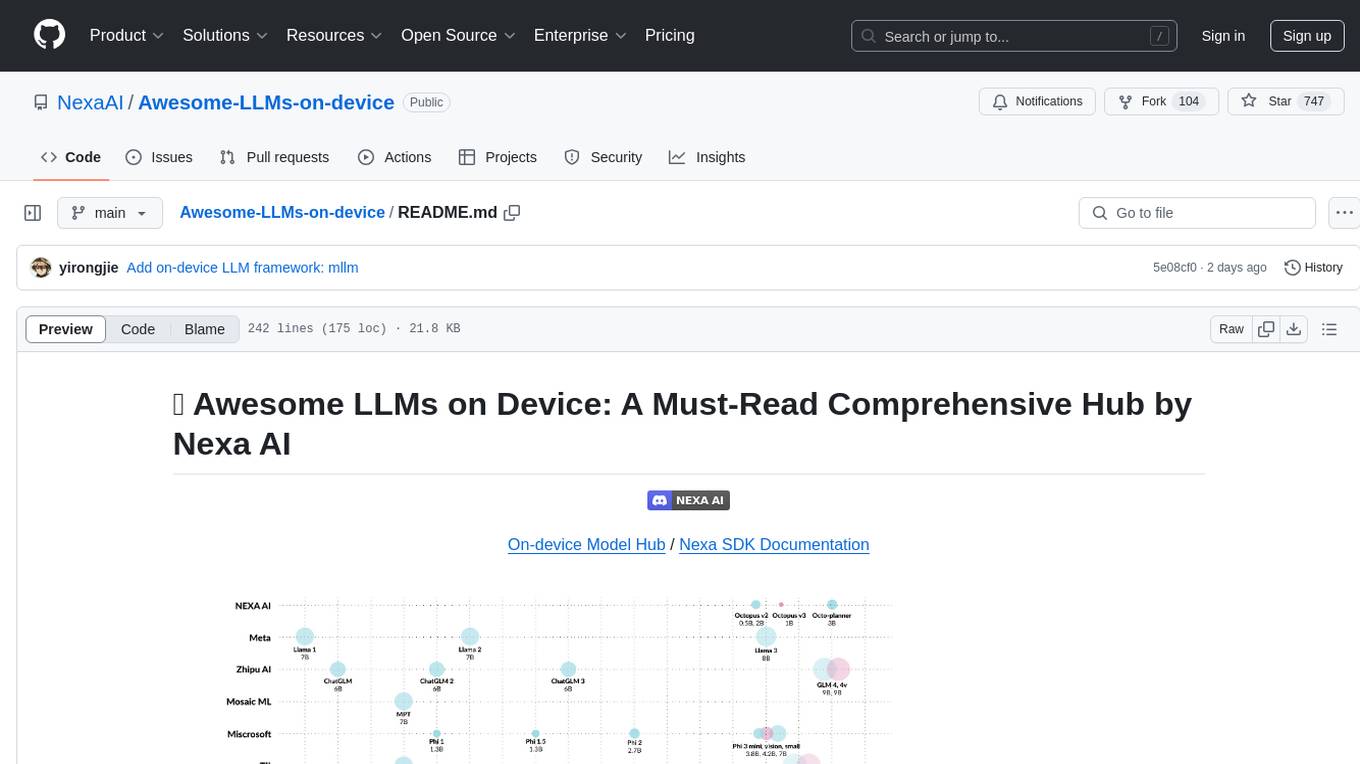
Welcome to the ultimate hub for on-device Large Language Models (LLMs)! This repository is your go-to resource for all things related to LLMs designed for on-device deployment. Whether you're a seasoned researcher, an innovative developer, or an enthusiastic learner, this comprehensive collection of cutting-edge knowledge is your gateway to understanding, leveraging, and contributing to the exciting world of on-device LLMs.
README:
Welcome to the ultimate hub for on-device Large Language Models (LLMs)! This repository is your go-to resource for all things related to LLMs designed for on-device deployment. Whether you're a seasoned researcher, an innovative developer, or an enthusiastic learner, this comprehensive collection of cutting-edge knowledge is your gateway to understanding, leveraging, and contributing to the exciting world of on-device LLMs.
- 📊 Comprehensive overview of on-device LLM evolution with easy-to-understand visualizations
- 🧠 In-depth analysis of groundbreaking architectures and optimization techniques
- 📱 Curated list of state-of-the-art models and frameworks ready for on-device deployment
- 💡 Practical examples and case studies to inspire your next project
- 🔄 Regular updates to keep you at the forefront of rapid advancements in the field
- 🤝 Active community of researchers and practitioners sharing insights and experiences
- Awesome LLMs on Device: A Comprehensive Survey
- Contents
- Tutorials and Learning Resources
- Citation
- Tinyllama: An open-source small language model
arXiv 2024 [Paper] [Github] - MobileVLM V2: Faster and Stronger Baseline for Vision Language Model
arXiv 2024 [Paper] [Github] - MobileAIBench: Benchmarking LLMs and LMMs for On-Device Use Cases
arXiv 2024 [Paper] - Octopus series papers
arXiv 2024 [Octopus] [Octopus v2] [Octopus v3] [Octopus v4] [Github] - The Era of 1-bit LLMs: All Large Language Models are in 1.58 Bits
arXiv 2024 [Paper] - AWQ: Activation-aware Weight Quantization for LLM Compression and Acceleration
arXiv 2023 [Paper] [Github]
- The case for 4-bit precision: k-bit inference scaling laws
ICML 2023 [Paper] - Challenges and applications of large language models
arXiv 2023 [Paper] - MiniLLM: Knowledge distillation of large language models
ICLR 2023 [Paper] [github] - Gptq: Accurate post-training quantization for generative pre-trained transformers
ICLR 2023 [Paper] [Github] - Gpt3. int8 (): 8-bit matrix multiplication for transformers at scale
NeurIPS 2022 [Paper]
- OpenELM: An Efficient Language Model Family with Open Training and Inference Framework
ICML 2024 [Paper] [Github]
- Ferret-v2: An Improved Baseline for Referring and Grounding with Large Language Models
arXiv 2024 [Paper] - Phi-3 Technical Report: A Highly Capable Language Model Locally on Your Phone
arXiv 2024 [Paper] - Exploring post-training quantization in llms from comprehensive study to low rank compensation
AAAI 2024 [Paper] - Matrix compression via randomized low rank and low precision factorization
NeurIPS 2023 [Paper] [Github]
- MNN: A lightweight deep neural network inference engine
2024 [Github] - PowerInfer-2: Fast Large Language Model Inference on a Smartphone
arXiv 2024 [Paper] [Github] - llama.cpp: Lightweight library for Approximate Nearest Neighbors and Maximum Inner Product Search
2023 [Github] - Powerinfer: Fast large language model serving with a consumer-grade gpu
arXiv 2023 [Paper] [Github] - mllm: Fast and lightweight multimodal LLM inference engine for mobile and edge devices
2023 [Github]
| Model | Performance | Computational Efficiency | Memory Requirements |
|---|---|---|---|
| MobileLLM | High accuracy, optimized for sub-billion parameter models | Embedding sharing, grouped-query attention | Reduced model size due to deep and thin structures |
| EdgeShard | Up to 50% latency reduction, 2× throughput improvement | Collaborative edge-cloud computing, optimal shard placement | Distributed model components reduce individual device load |
| LLMCad | Up to 9.3× speedup in token generation | Generate-then-verify, token tree generation | Smaller LLM for token generation, larger LLM for verification |
| Any-Precision LLM | Supports multiple precisions efficiently | Post-training quantization, memory-efficient design | Substantial memory savings with versatile model precisions |
| Breakthrough Memory | Up to 4.5× performance improvement | PIM and PNM technologies enhance memory processing | Enhanced memory bandwidth and capacity |
| MELTing Point | Provides systematic performance evaluation | Analyzes impacts of quantization, efficient model evaluation | Evaluates memory and computational efficiency trade-offs |
| LLMaaS on device | Reduces context switching latency significantly | Stateful execution, fine-grained KV cache compression | Efficient memory management with tolerance-aware compression and swapping |
| LocMoE | Reduces training time per epoch by up to 22.24% | Orthogonal gating weights, locality-based expert regularization | Minimizes communication overhead with group-wise All-to-All and recompute pipeline |
| EdgeMoE | Significant performance improvements on edge devices | Expert-wise bitwidth adaptation, preloading experts | Efficient memory management through expert-by-expert computation reordering |
| JetMoE | Outperforms Llama27B and 13B-Chat with fewer parameters | Reduces inference computation by 70% using sparse activation | 8B total parameters, only 2B activated per input token |
Pangu-$\pi$ Pro |
Neural architecture, parameter initialization, and optimization strategy for billion-level parameter models | Embedding sharing, tokenizer compression | Reduced model size via architecture tweaking |
- AWQ: Activation-aware Weight Quantization for LLM Compression and Acceleration
arXiv 2024 [Paper] [Github] - MobileLLM: Optimizing Sub-billion Parameter Language Models for On-Device Use Cases
arXiv 2024 [Paper] [Github]
- EdgeShard: Efficient LLM Inference via Collaborative Edge Computing
arXiv 2024 [Paper] - Llmcad: Fast and scalable on-device large language model inference
arXiv 2023 [Paper]
- The Breakthrough Memory Solutions for Improved Performance on LLM Inference
IEEE Micro 2024 [Paper] - MELTing point: Mobile Evaluation of Language Transformers
arXiv 2024 [Paper] [Github]
- LLM as a system service on mobile devices
arXiv 2024 [Paper] - Locmoe: A low-overhead moe for large language model training
arXiv 2024 [Paper] - Edgemoe: Fast on-device inference of moe-based large language models
arXiv 2023 [Paper]
- Any-Precision LLM: Low-Cost Deployment of Multiple, Different-Sized LLMs
arXiv 2024 [Paper] [Github] - On the viability of using llms for sw/hw co-design: An example in designing cim dnn accelerators
IEEE SOCC 2023 [Paper]
- The Era of 1-bit LLMs: All Large Language Models are in 1.58 Bits
arXiv 2024 [Paper] - AWQ: Activation-aware Weight Quantization for LLM Compression and Acceleration
arXiv 2024 [Paper] [Github] - Gptq: Accurate post-training quantization for generative pre-trained transformers
ICLR 2023 [Paper] [Github] - Gpt3. int8 (): 8-bit matrix multiplication for transformers at scale
NeurIPS 2022 [Paper]
- Challenges and applications of large language models
arXiv 2023 [Paper]
- MiniLLM: Knowledge distillation of large language models
ICLR 2024 [Paper]
- Exploring post-training quantization in llms from comprehensive study to low rank compensation
AAAI 2024 [Paper] - Matrix compression via randomized low rank and low precision factorization
NeurIPS 2023 [Paper] [Github]
- llama.cpp: A lightweight library for efficient LLM inference on various hardware with minimal setup. [Github]
- MNN: A blazing fast, lightweight deep learning framework. [Github]
- PowerInfer: A CPU/GPU LLM inference engine leveraging activation locality for device. [Github]
- ExecuTorch: A platform for On-device AI across mobile, embedded and edge for PyTorch. [Github]
- MediaPipe: A suite of tools and libraries, enables quick application of AI and ML techniques. [Github]
- MLC-LLM: A machine learning compiler and high-performance deployment engine for large language models. [Github]
- VLLM: A fast and easy-to-use library for LLM inference and serving. [Github]
- OpenLLM: An open platform for operating large language models (LLMs) in production. [Github]
- The Breakthrough Memory Solutions for Improved Performance on LLM Inference
IEEE Micro 2024 [Paper] - Aquabolt-XL: Samsung HBM2-PIM with in-memory processing for ML accelerators and beyond
IEEE Hot Chips 2021 [Paper]
- Text Generating For Messaging: Gboard smart reply
- Translation: LLMCad
- Meeting Summarizing
- Healthcare application: BioMistral-7B, HuatuoGPT
- Research Support
- Companion Robot
- Disability Support: Octopus v3, Talkback with Gemini Nano
- Autonomous Vehicles: DriveVLM
| Model | Institute | Paper |
|---|---|---|
| Gemini Nano | Gemini: A Family of Highly Capable Multimodal Models | |
| Octopus series model | Nexa AI |
Octopus v2: On-device language model for super agent Octopus v3: Technical Report for On-device Sub-billion Multimodal AI Agent Octopus v4: Graph of language models Octopus: On-device language model for function calling of software APIs |
| OpenELM and Ferret-v2 | Apple |
OpenELM is a significant large language model integrated within iOS to enhance application functionalities. Ferret-v2 significantly improves upon its predecessor, introducing enhanced visual processing capabilities and an advanced training regimen. |
| Phi series | Microsoft | Phi-3 Technical Report: A Highly Capable Language Model Locally on Your Phone |
| MiniCPM | Tsinghua University | A GPT-4V Level Multimodal LLM on Your Phone |
| Gemma2-9B | Gemma 2: Improving Open Language Models at a Practical Size | |
| Qwen2-0.5B | Alibaba Group | Qwen Technical Report |
- MIT: TinyML and Efficient Deep Learning Computing
- Harvard: Machine Learning Systems
- Deep Learning AI : Introduction to on-device AI
We believe in the power of community! If you're passionate about on-device AI and want to contribute to this ever-growing knowledge hub, here's how you can get involved:
- Fork the repository
- Create a new branch for your brilliant additions
- Make your updates and push your changes
- Submit a pull request and become part of the on-device LLM movement
If our hub fuels your research or powers your projects, we'd be thrilled if you could cite our paper here:
@article{xu2024device,
title={On-Device Language Models: A Comprehensive Review},
author={Xu, Jiajun and Li, Zhiyuan and Chen, Wei and Wang, Qun and Gao, Xin and Cai, Qi and Ling, Ziyuan},
journal={arXiv preprint arXiv:2409.00088},
year={2024}
}This project is open-source and available under the MIT License. See the LICENSE file for more details.
Don't just read about the future of AI – be part of it. Star this repo, spread the word, and let's push the boundaries of on-device LLMs together! 🚀🌟
For Tasks:
Click tags to check more tools for each tasksFor Jobs:
Alternative AI tools for Awesome-LLMs-on-device
Similar Open Source Tools

Awesome-LLMs-on-device
Welcome to the ultimate hub for on-device Large Language Models (LLMs)! This repository is your go-to resource for all things related to LLMs designed for on-device deployment. Whether you're a seasoned researcher, an innovative developer, or an enthusiastic learner, this comprehensive collection of cutting-edge knowledge is your gateway to understanding, leveraging, and contributing to the exciting world of on-device LLMs.
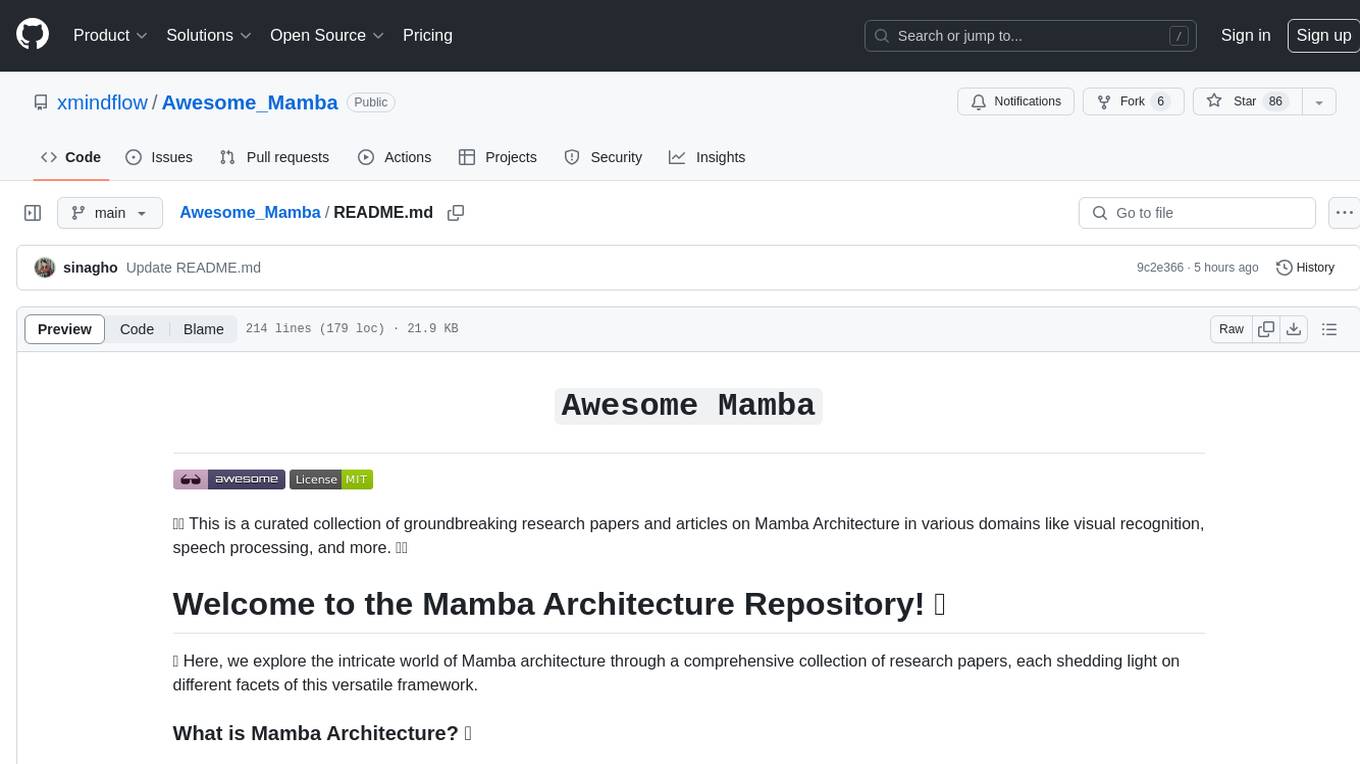
Awesome_Mamba
Awesome Mamba is a curated collection of groundbreaking research papers and articles on Mamba Architecture, a pioneering framework in deep learning known for its selective state spaces and efficiency in processing complex data structures. The repository offers a comprehensive exploration of Mamba architecture through categorized research papers covering various domains like visual recognition, speech processing, remote sensing, video processing, activity recognition, image enhancement, medical imaging, reinforcement learning, natural language processing, 3D recognition, multi-modal understanding, time series analysis, graph neural networks, point cloud analysis, and tabular data handling.
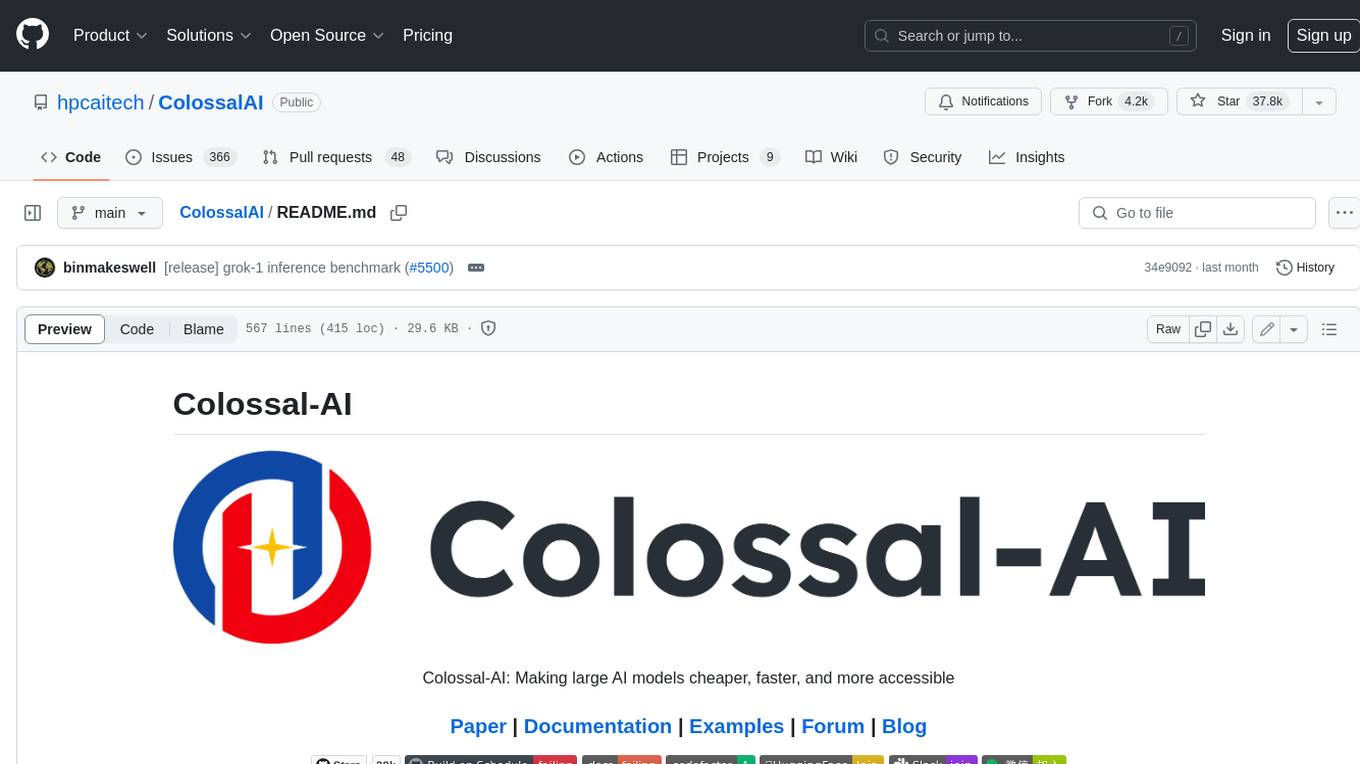
ColossalAI
Colossal-AI is a deep learning system for large-scale parallel training. It provides a unified interface to scale sequential code of model training to distributed environments. Colossal-AI supports parallel training methods such as data, pipeline, tensor, and sequence parallelism and is integrated with heterogeneous training and zero redundancy optimizer.
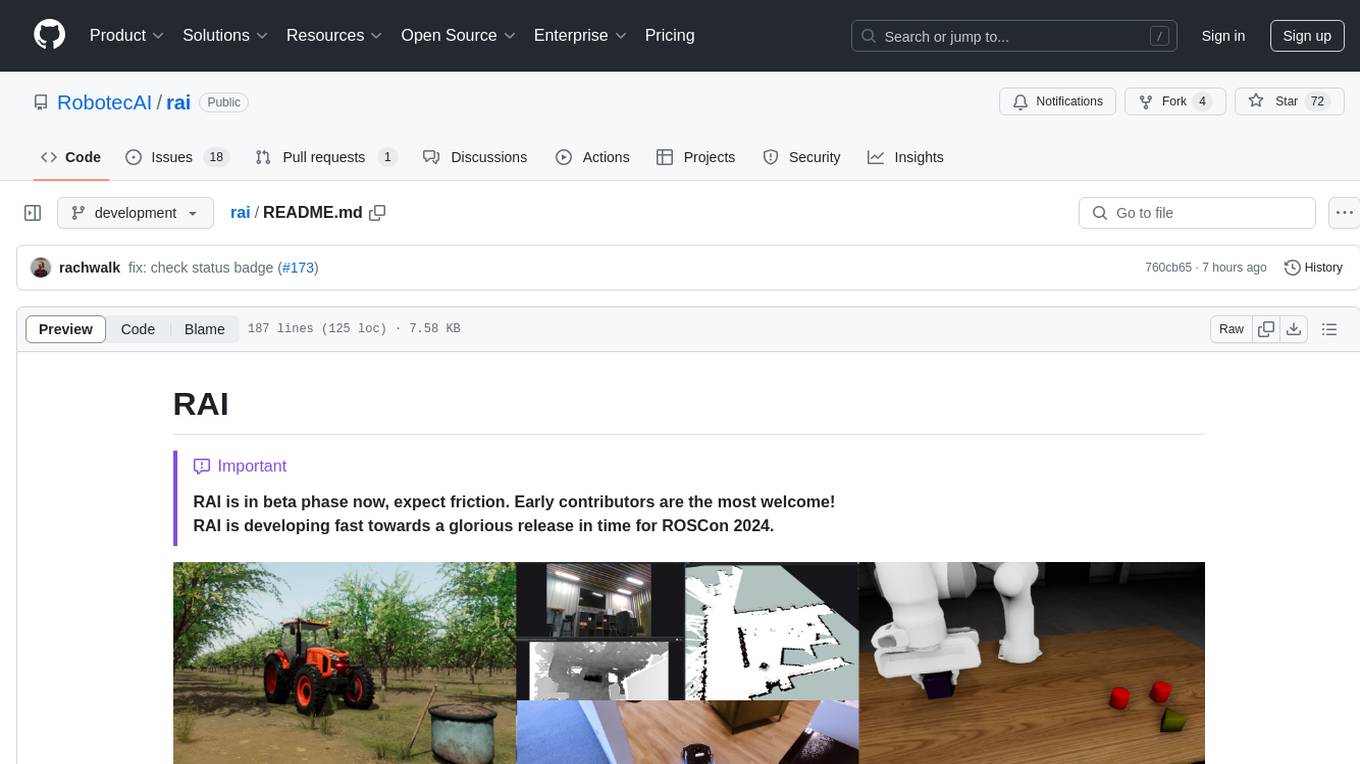
rai
RAI is a framework designed to bring general multi-agent system capabilities to robots, enhancing human interactivity, flexibility in problem-solving, and out-of-the-box AI features. It supports multi-modalities, incorporates an advanced database for agent memory, provides ROS 2-oriented tooling, and offers a comprehensive task/mission orchestrator. The framework includes features such as voice interaction, customizable robot identity, camera sensor access, reasoning through ROS logs, and integration with LangChain for AI tools. RAI aims to support various AI vendors, improve human-robot interaction, provide an SDK for developers, and offer a user interface for configuration.
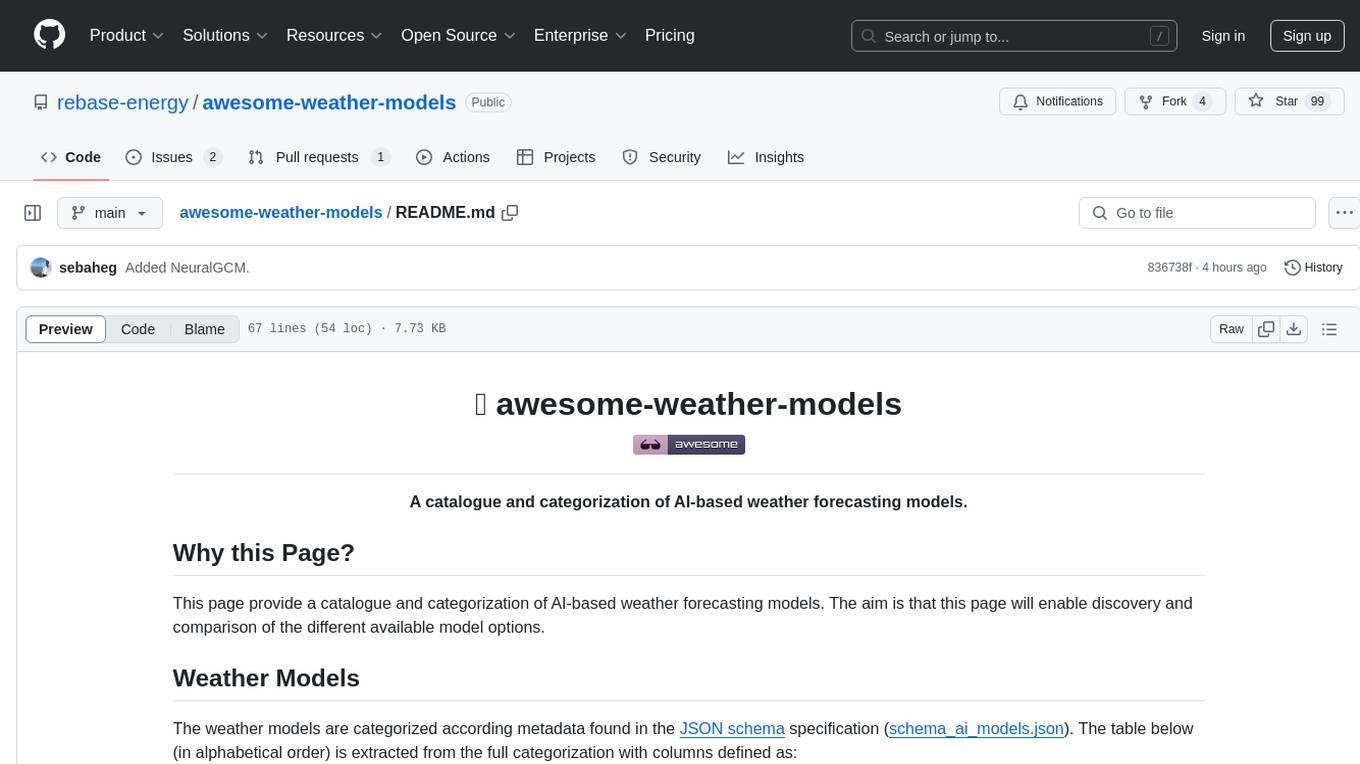
awesome-weather-models
A catalogue and categorization of AI-based weather forecasting models. This page provides a catalogue and categorization of AI-based weather forecasting models to enable discovery and comparison of different available model options. The weather models are categorized based on metadata found in the JSON schema specification. The table includes information such as the name of the weather model, the organization that developed it, operational data availability, open-source status, and links for further details.
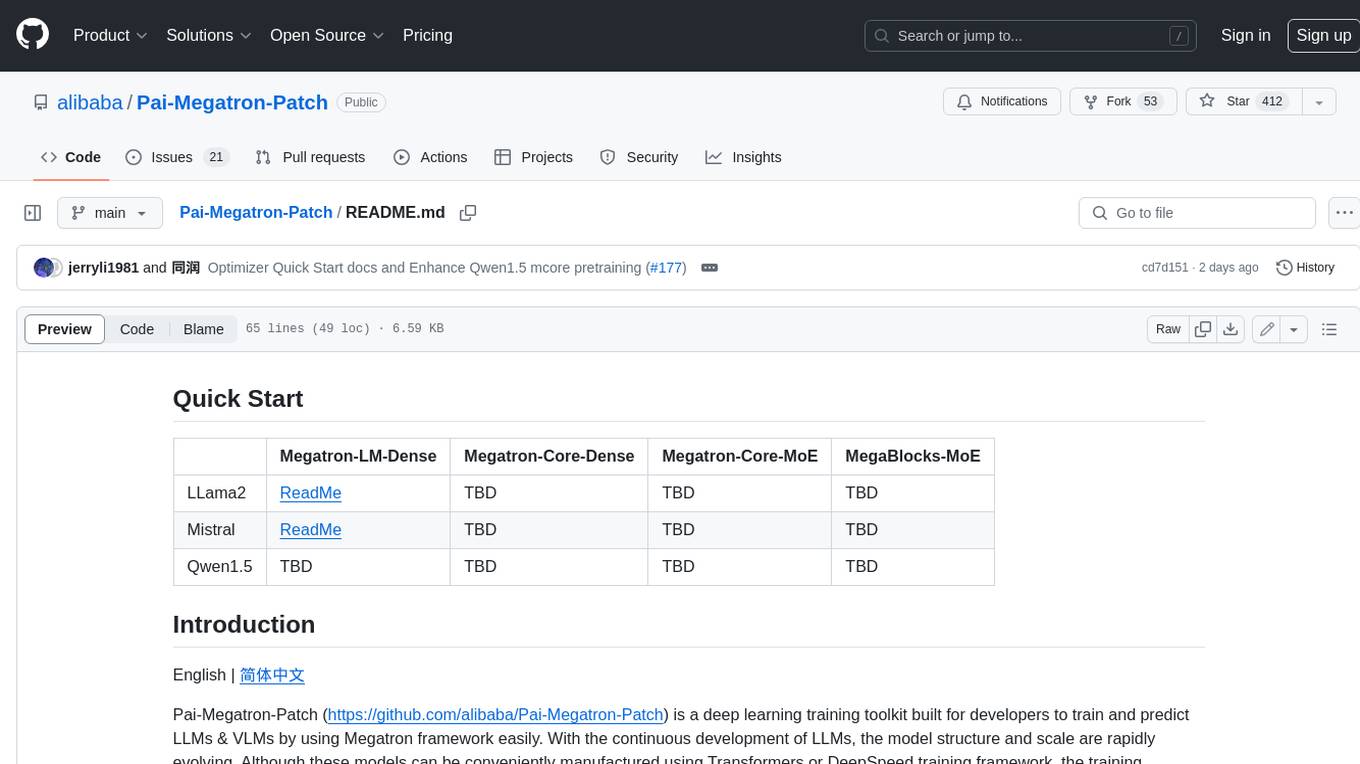
Pai-Megatron-Patch
Pai-Megatron-Patch is a deep learning training toolkit built for developers to train and predict LLMs & VLMs by using Megatron framework easily. With the continuous development of LLMs, the model structure and scale are rapidly evolving. Although these models can be conveniently manufactured using Transformers or DeepSpeed training framework, the training efficiency is comparably low. This phenomenon becomes even severer when the model scale exceeds 10 billion. The primary objective of Pai-Megatron-Patch is to effectively utilize the computational power of GPUs for LLM. This tool allows convenient training of commonly used LLM with all the accelerating techniques provided by Megatron-LM.
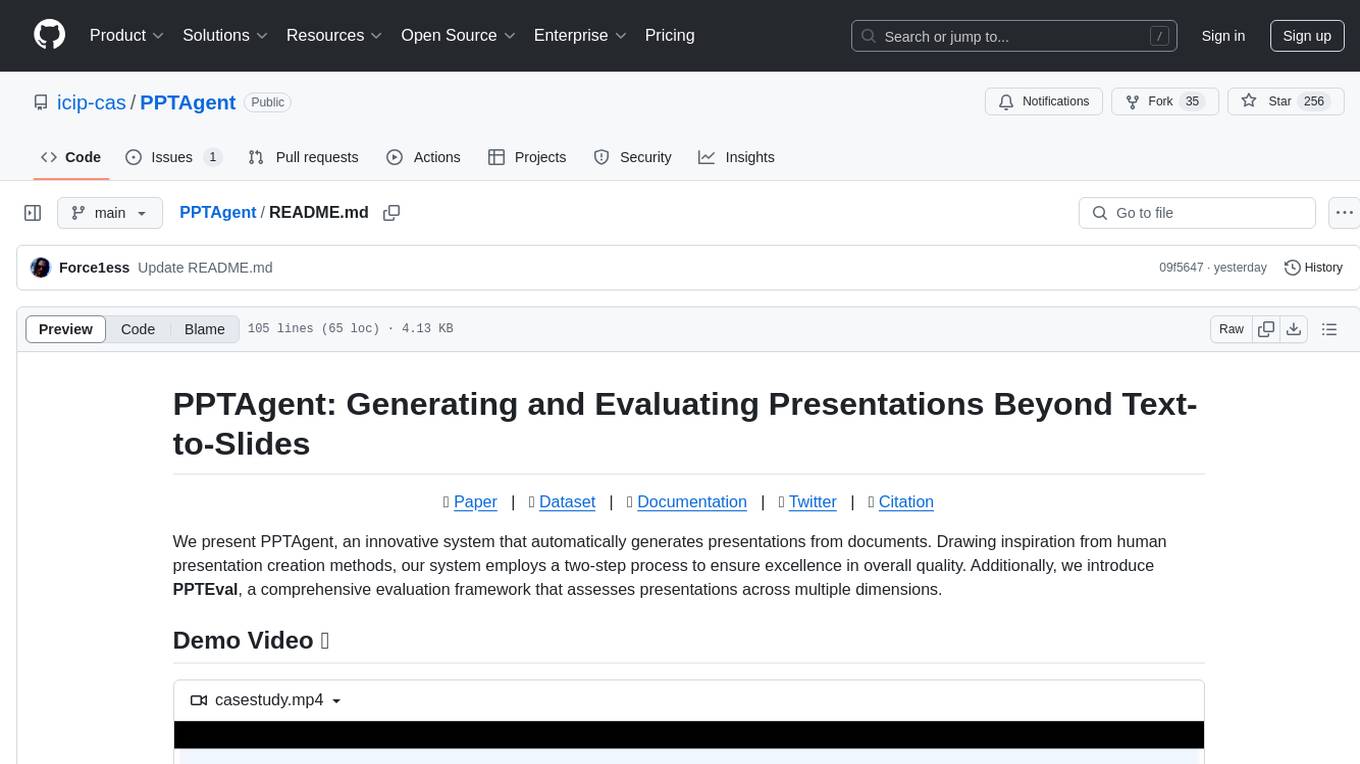
PPTAgent
PPTAgent is an innovative system that automatically generates presentations from documents. It employs a two-step process for quality assurance and introduces PPTEval for comprehensive evaluation. With dynamic content generation, smart reference learning, and quality assessment, PPTAgent aims to streamline presentation creation. The tool follows an analysis phase to learn from reference presentations and a generation phase to develop structured outlines and cohesive slides. PPTEval evaluates presentations based on content accuracy, visual appeal, and logical coherence.
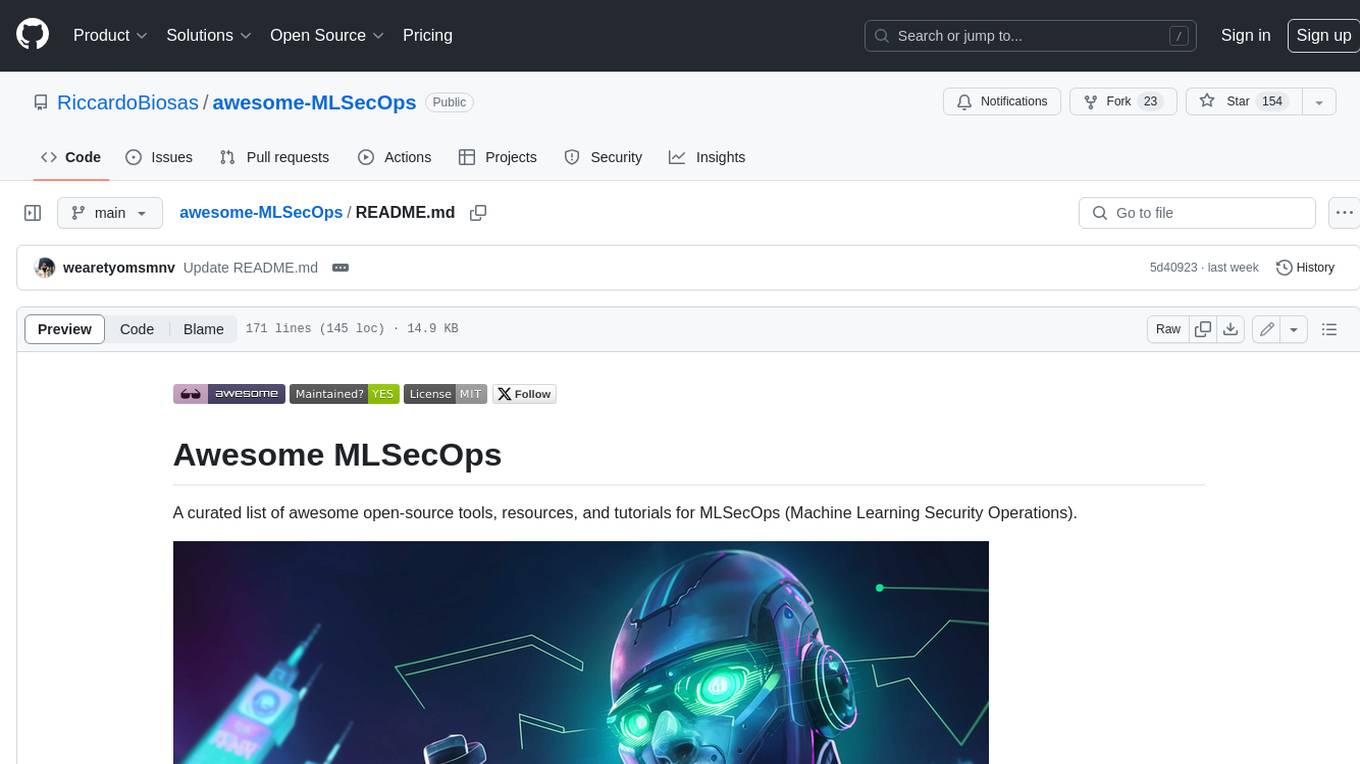
awesome-MLSecOps
Awesome MLSecOps is a curated list of open-source tools, resources, and tutorials for MLSecOps (Machine Learning Security Operations). It includes a wide range of security tools and libraries for protecting machine learning models against adversarial attacks, as well as resources for AI security, data anonymization, model security, and more. The repository aims to provide a comprehensive collection of tools and information to help users secure their machine learning systems and infrastructure.
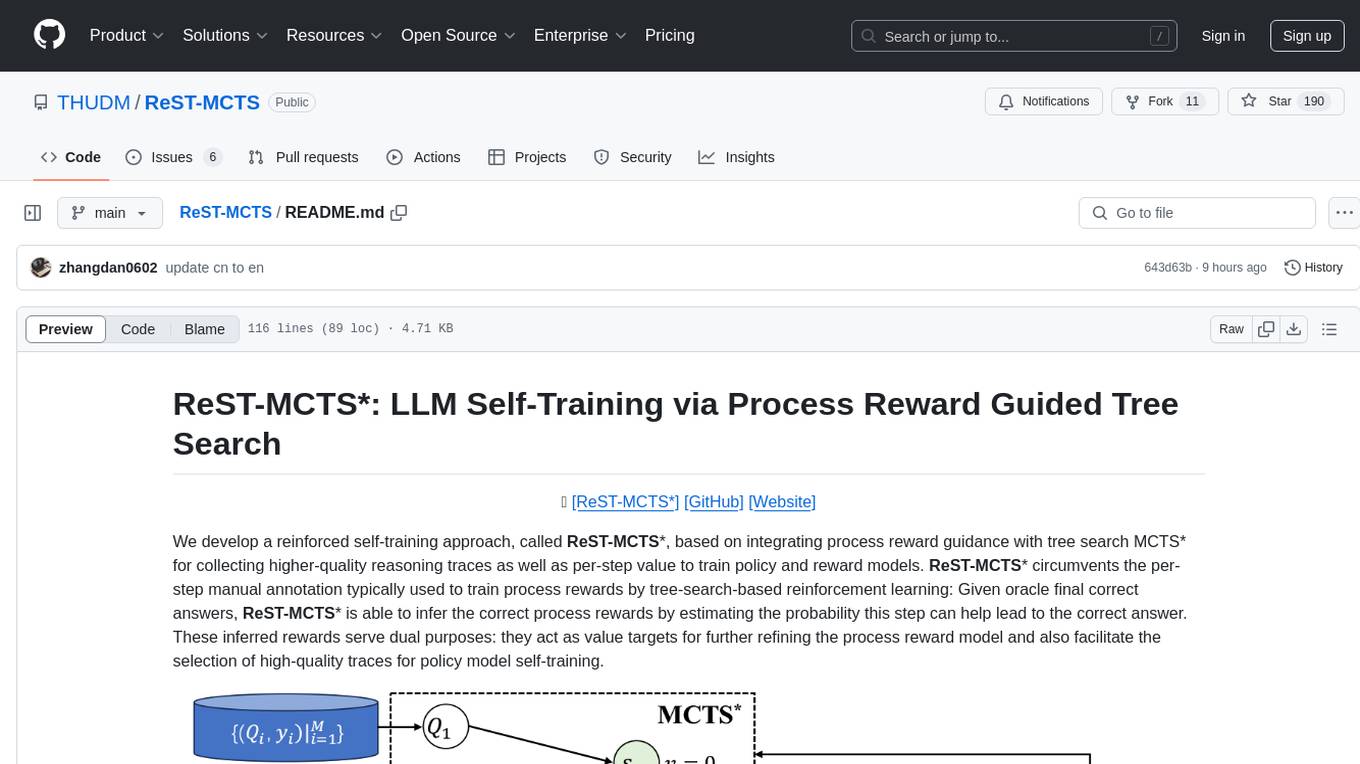
ReST-MCTS
ReST-MCTS is a reinforced self-training approach that integrates process reward guidance with tree search MCTS to collect higher-quality reasoning traces and per-step value for training policy and reward models. It eliminates the need for manual per-step annotation by estimating the probability of steps leading to correct answers. The inferred rewards refine the process reward model and aid in selecting high-quality traces for policy model self-training.
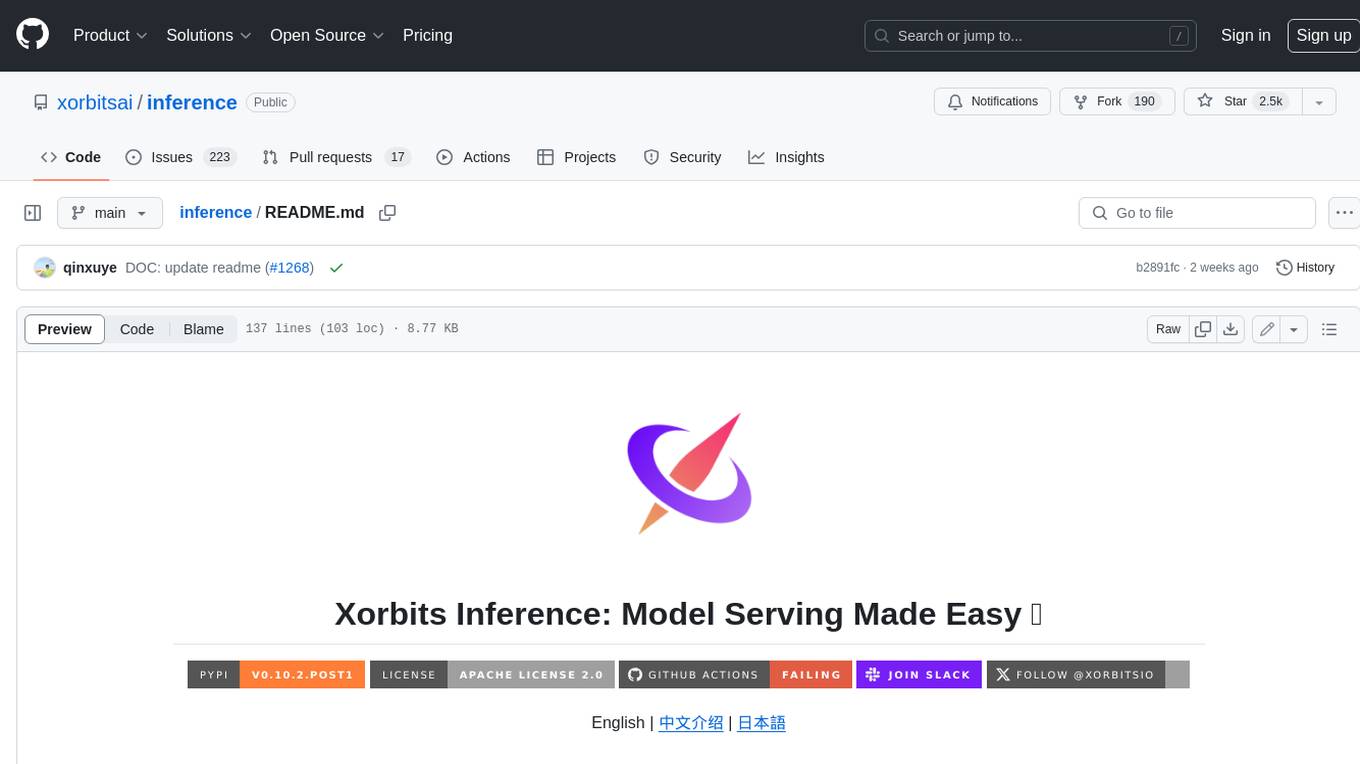
inference
Xorbits Inference (Xinference) is a powerful and versatile library designed to serve language, speech recognition, and multimodal models. With Xorbits Inference, you can effortlessly deploy and serve your or state-of-the-art built-in models using just a single command. Whether you are a researcher, developer, or data scientist, Xorbits Inference empowers you to unleash the full potential of cutting-edge AI models.
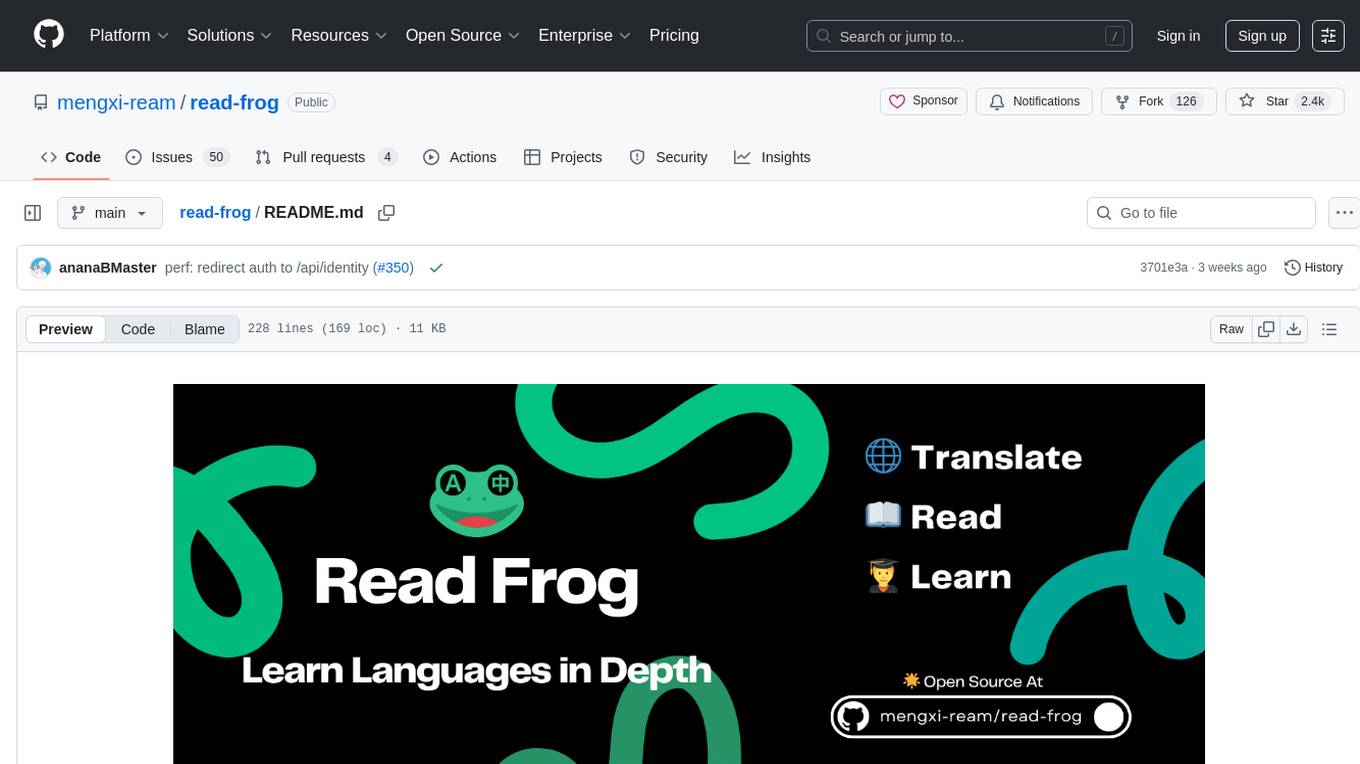
read-frog
Read-frog is a powerful text analysis tool designed to help users extract valuable insights from text data. It offers a wide range of features including sentiment analysis, keyword extraction, entity recognition, and text summarization. With its user-friendly interface and robust algorithms, Read-frog is suitable for both beginners and advanced users looking to analyze text data for various purposes such as market research, social media monitoring, and content optimization. Whether you are a data scientist, marketer, researcher, or student, Read-frog can streamline your text analysis workflow and provide actionable insights to drive decision-making and enhance productivity.
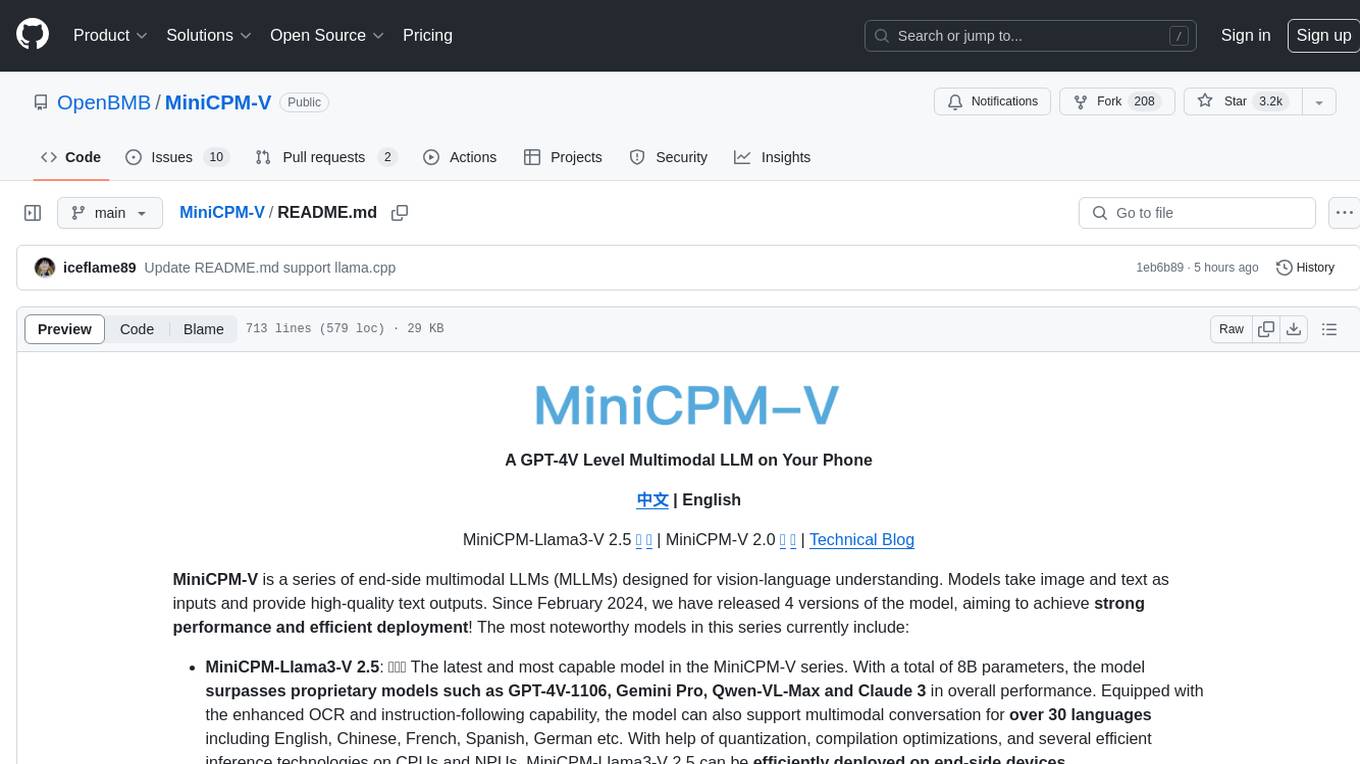
MiniCPM-V
MiniCPM-V is a series of end-side multimodal LLMs designed for vision-language understanding. The models take image and text inputs to provide high-quality text outputs. The series includes models like MiniCPM-Llama3-V 2.5 with 8B parameters surpassing proprietary models, and MiniCPM-V 2.0, a lighter model with 2B parameters. The models support over 30 languages, efficient deployment on end-side devices, and have strong OCR capabilities. They achieve state-of-the-art performance on various benchmarks and prevent hallucinations in text generation. The models can process high-resolution images efficiently and support multilingual capabilities.
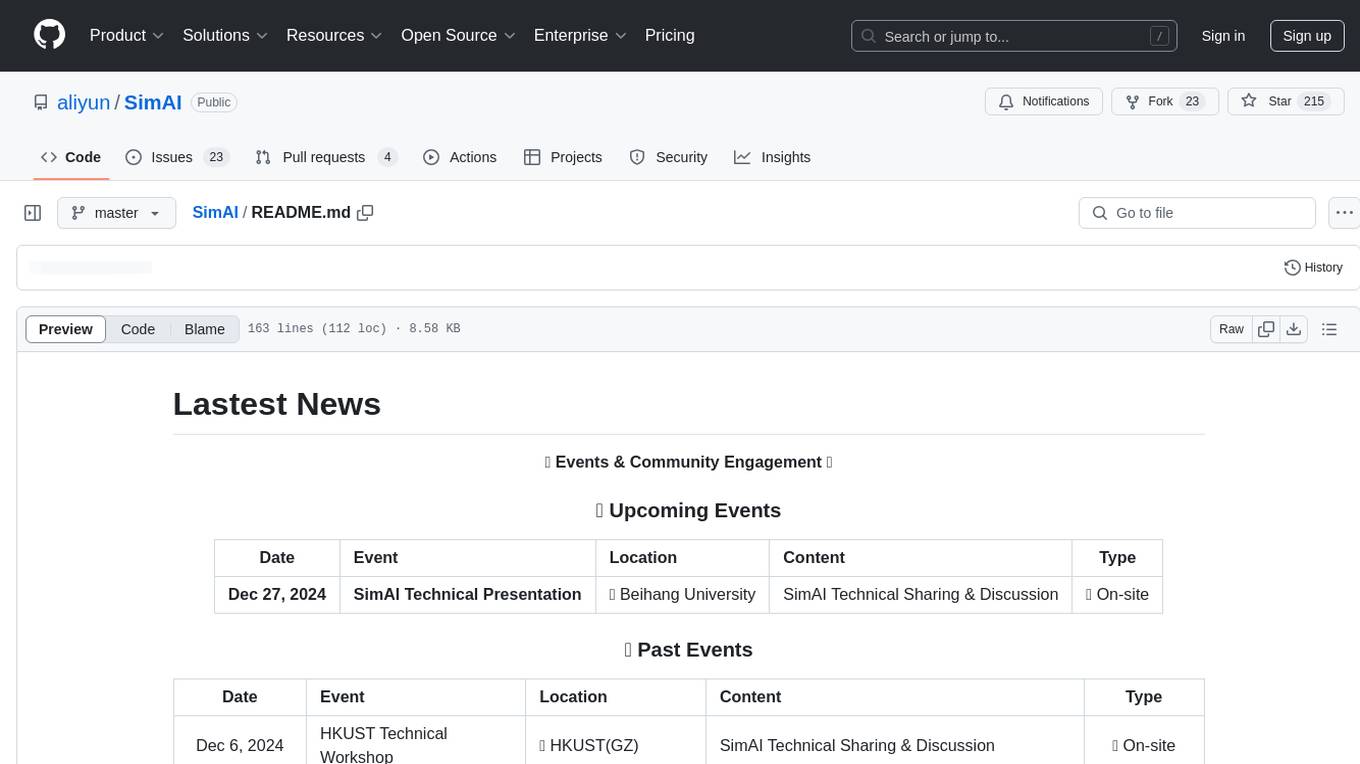
SimAI
SimAI is the industry's first full-stack, high-precision simulator for AI large-scale training. It provides detailed modeling and simulation of the entire LLM training process, encompassing framework, collective communication, network layers, and more. This comprehensive approach offers end-to-end performance data, enabling researchers to analyze training process details, evaluate time consumption of AI tasks under specific conditions, and assess performance gains from various algorithmic optimizations.
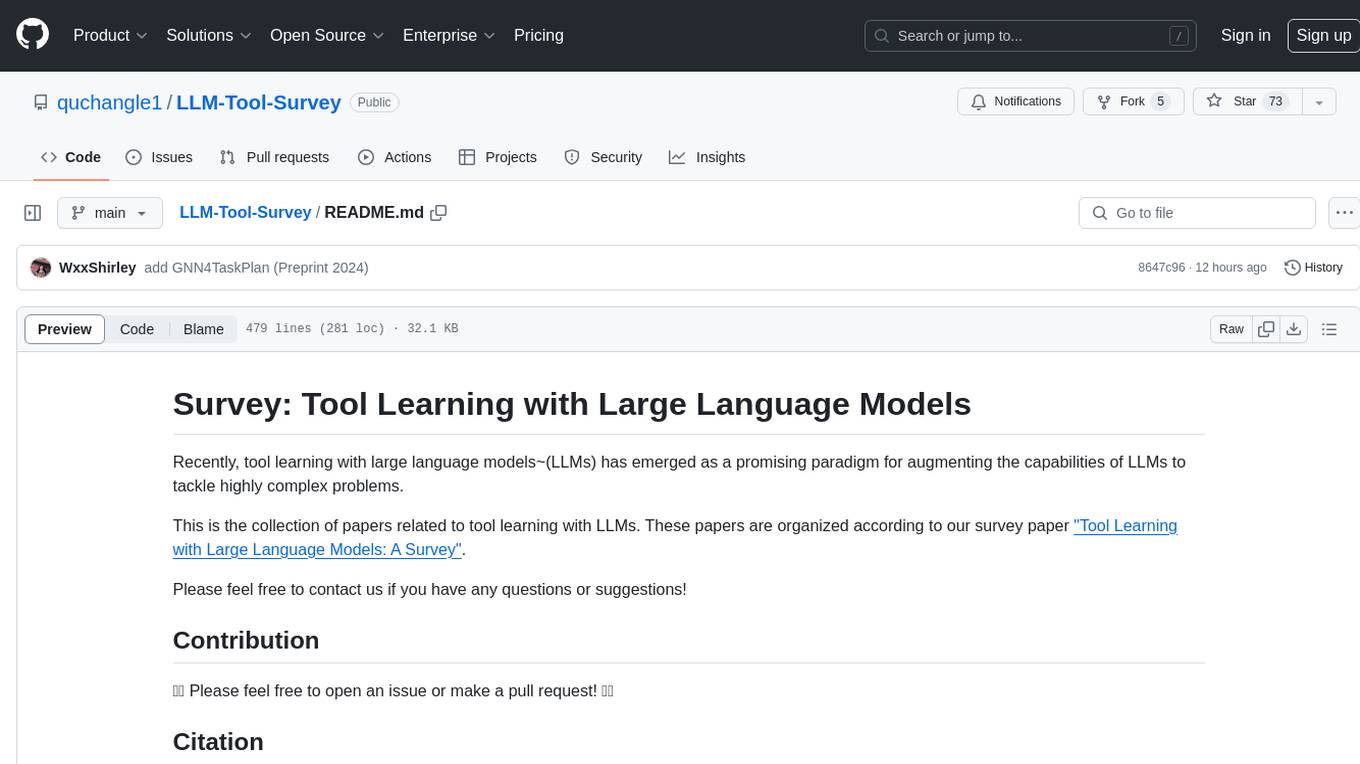
LLM-Tool-Survey
This repository contains a collection of papers related to tool learning with large language models (LLMs). The papers are organized according to the survey paper 'Tool Learning with Large Language Models: A Survey'. The survey focuses on the benefits and implementation of tool learning with LLMs, covering aspects such as task planning, tool selection, tool calling, response generation, benchmarks, evaluation, challenges, and future directions in the field. It aims to provide a comprehensive understanding of tool learning with LLMs and inspire further exploration in this emerging area.
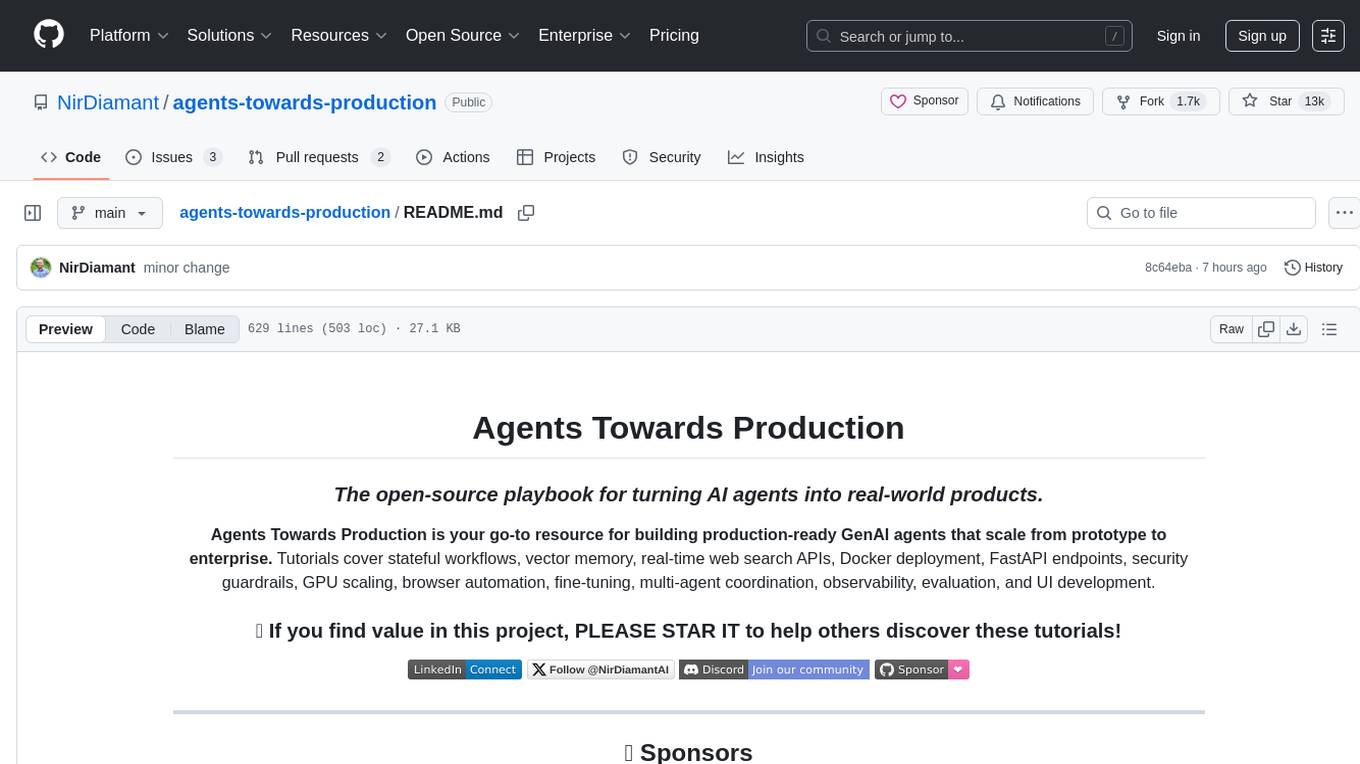
agents-towards-production
Agents Towards Production is an open-source playbook for building production-ready GenAI agents that scale from prototype to enterprise. Tutorials cover stateful workflows, vector memory, real-time web search APIs, Docker deployment, FastAPI endpoints, security guardrails, GPU scaling, browser automation, fine-tuning, multi-agent coordination, observability, evaluation, and UI development.
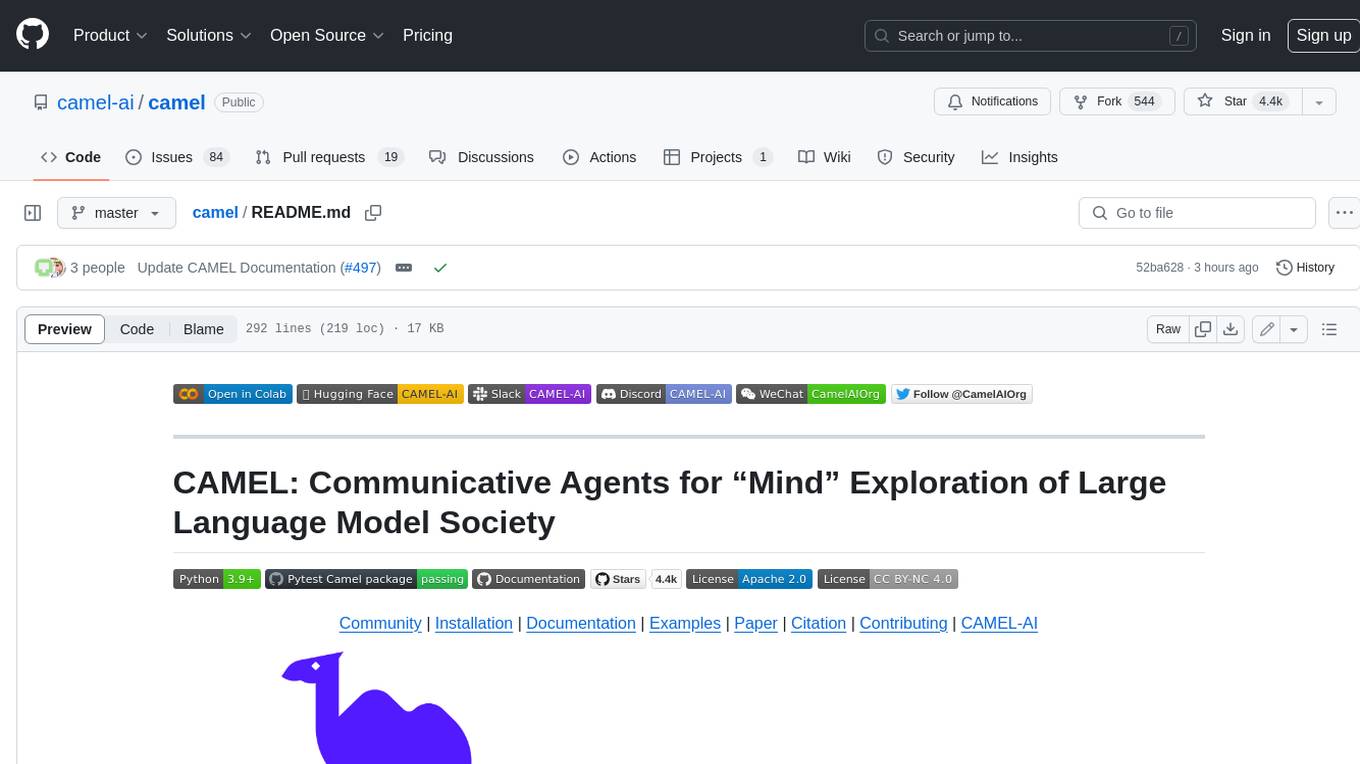
camel
CAMEL is an open-source library designed for the study of autonomous and communicative agents. We believe that studying these agents on a large scale offers valuable insights into their behaviors, capabilities, and potential risks. To facilitate research in this field, we implement and support various types of agents, tasks, prompts, models, and simulated environments.
For similar tasks
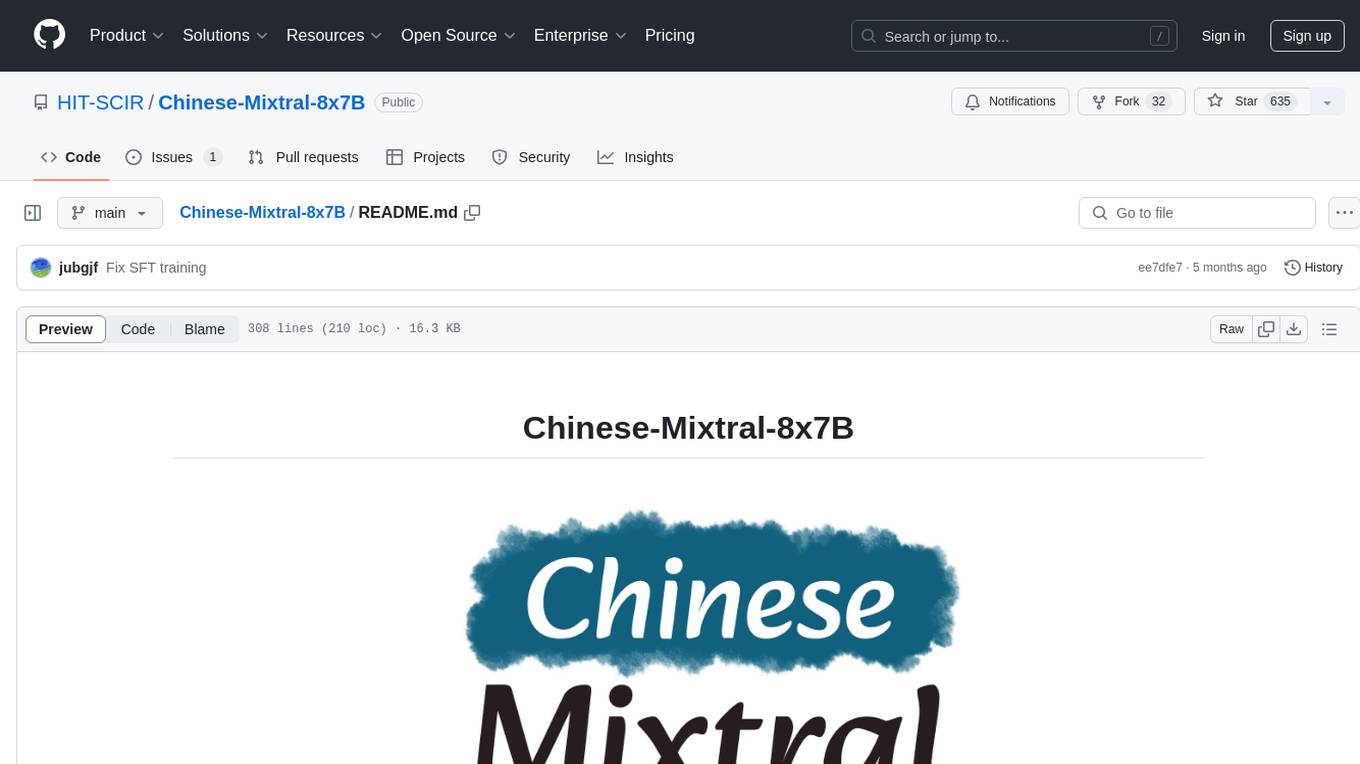
Chinese-Mixtral-8x7B
Chinese-Mixtral-8x7B is an open-source project based on Mistral's Mixtral-8x7B model for incremental pre-training of Chinese vocabulary, aiming to advance research on MoE models in the Chinese natural language processing community. The expanded vocabulary significantly improves the model's encoding and decoding efficiency for Chinese, and the model is pre-trained incrementally on a large-scale open-source corpus, enabling it with powerful Chinese generation and comprehension capabilities. The project includes a large model with expanded Chinese vocabulary and incremental pre-training code.

Awesome-LLMs-on-device
Welcome to the ultimate hub for on-device Large Language Models (LLMs)! This repository is your go-to resource for all things related to LLMs designed for on-device deployment. Whether you're a seasoned researcher, an innovative developer, or an enthusiastic learner, this comprehensive collection of cutting-edge knowledge is your gateway to understanding, leveraging, and contributing to the exciting world of on-device LLMs.
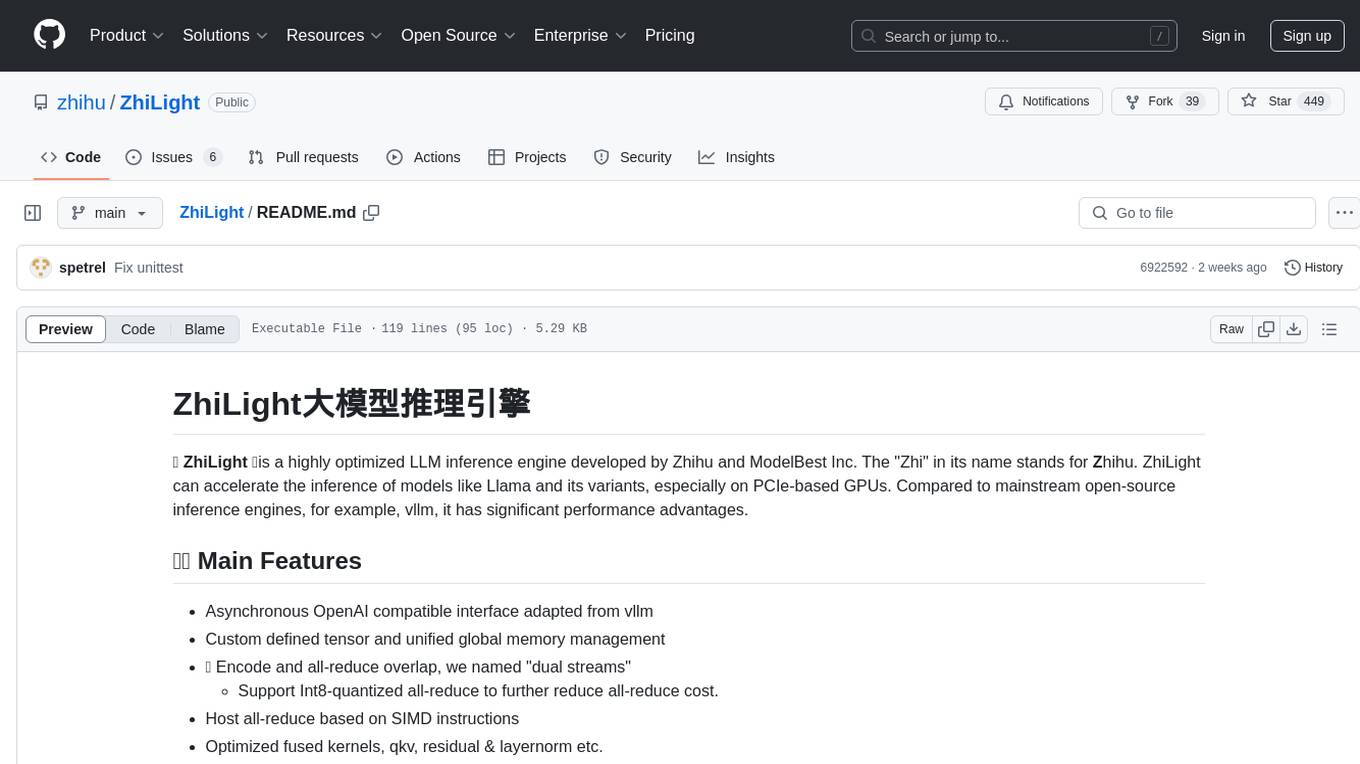
ZhiLight
ZhiLight is a highly optimized large language model (LLM) inference engine developed by Zhihu and ModelBest Inc. It accelerates the inference of models like Llama and its variants, especially on PCIe-based GPUs. ZhiLight offers significant performance advantages compared to mainstream open-source inference engines. It supports various features such as custom defined tensor and unified global memory management, optimized fused kernels, support for dynamic batch, flash attention prefill, prefix cache, and different quantization techniques like INT8, SmoothQuant, FP8, AWQ, and GPTQ. ZhiLight is compatible with OpenAI interface and provides high performance on mainstream NVIDIA GPUs with different model sizes and precisions.
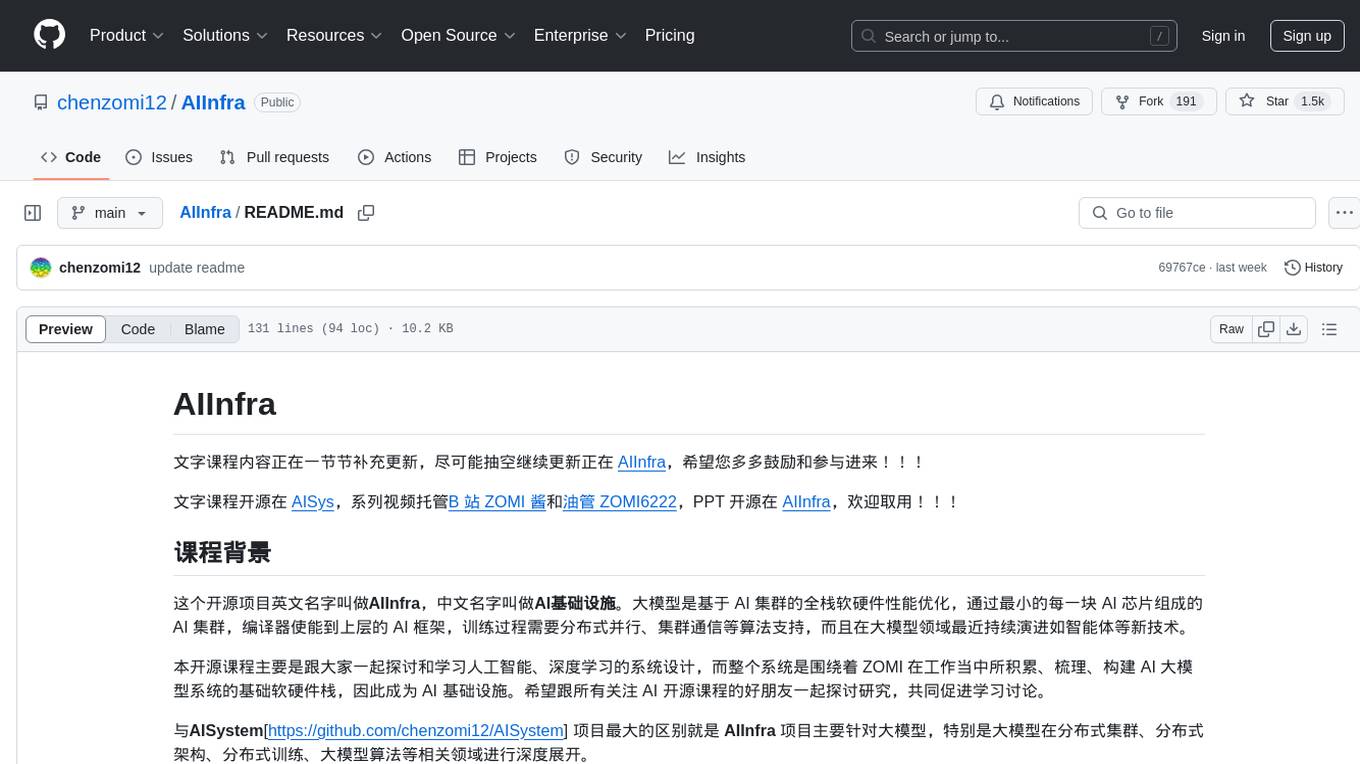
AIInfra
AIInfra is an open-source project focused on AI infrastructure, specifically targeting large models in distributed clusters, distributed architecture, distributed training, and algorithms related to large models. The project aims to explore and study system design in artificial intelligence and deep learning, with a focus on the hardware and software stack for building AI large model systems. It provides a comprehensive curriculum covering topics such as AI chip principles, communication and storage, AI clusters, large model training, and inference, as well as algorithms for large models. The course is designed for undergraduate and graduate students, as well as professionals working with AI large model systems, to gain a deep understanding of AI computer system architecture and design.
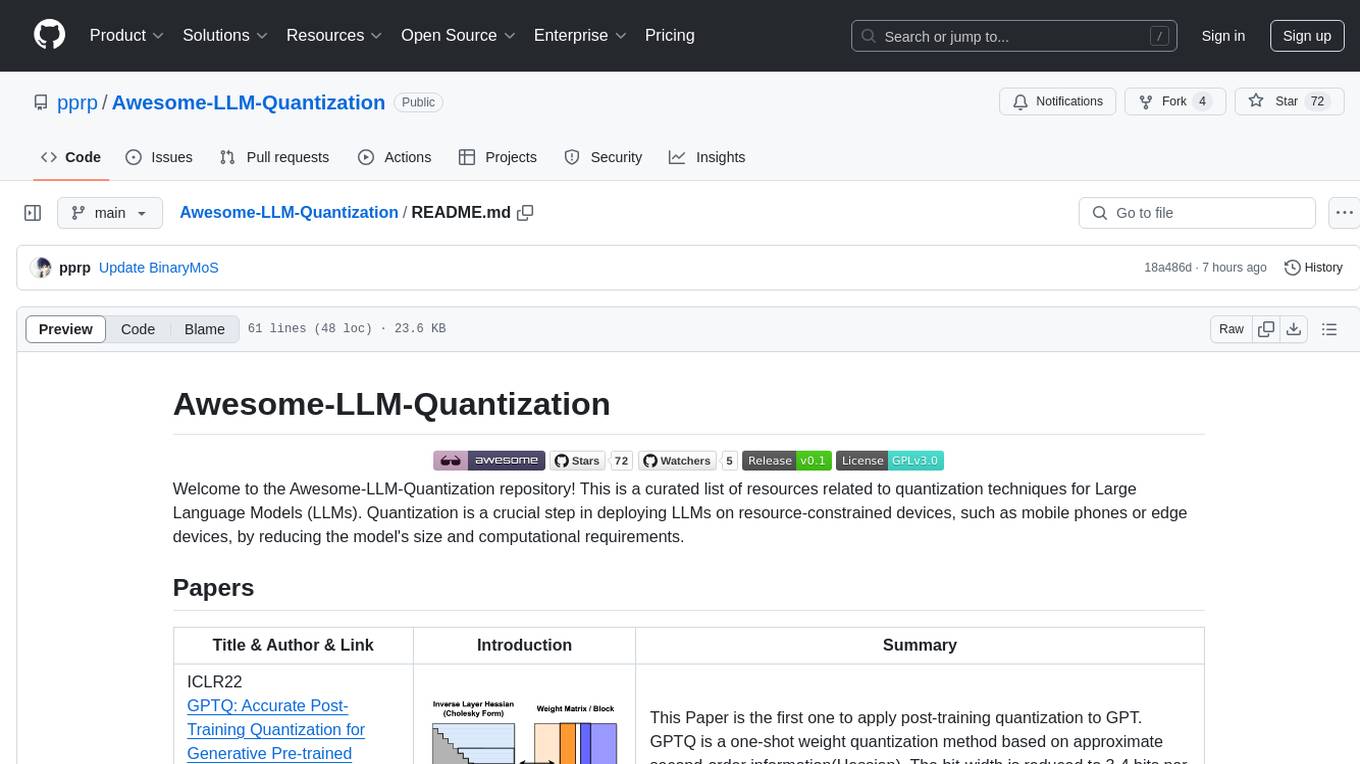
Awesome-LLM-Quantization
Awesome-LLM-Quantization is a curated list of resources related to quantization techniques for Large Language Models (LLMs). Quantization is a crucial step in deploying LLMs on resource-constrained devices, such as mobile phones or edge devices, by reducing the model's size and computational requirements.
For similar jobs

Awesome_Mamba
Awesome Mamba is a curated collection of groundbreaking research papers and articles on Mamba Architecture, a pioneering framework in deep learning known for its selective state spaces and efficiency in processing complex data structures. The repository offers a comprehensive exploration of Mamba architecture through categorized research papers covering various domains like visual recognition, speech processing, remote sensing, video processing, activity recognition, image enhancement, medical imaging, reinforcement learning, natural language processing, 3D recognition, multi-modal understanding, time series analysis, graph neural networks, point cloud analysis, and tabular data handling.
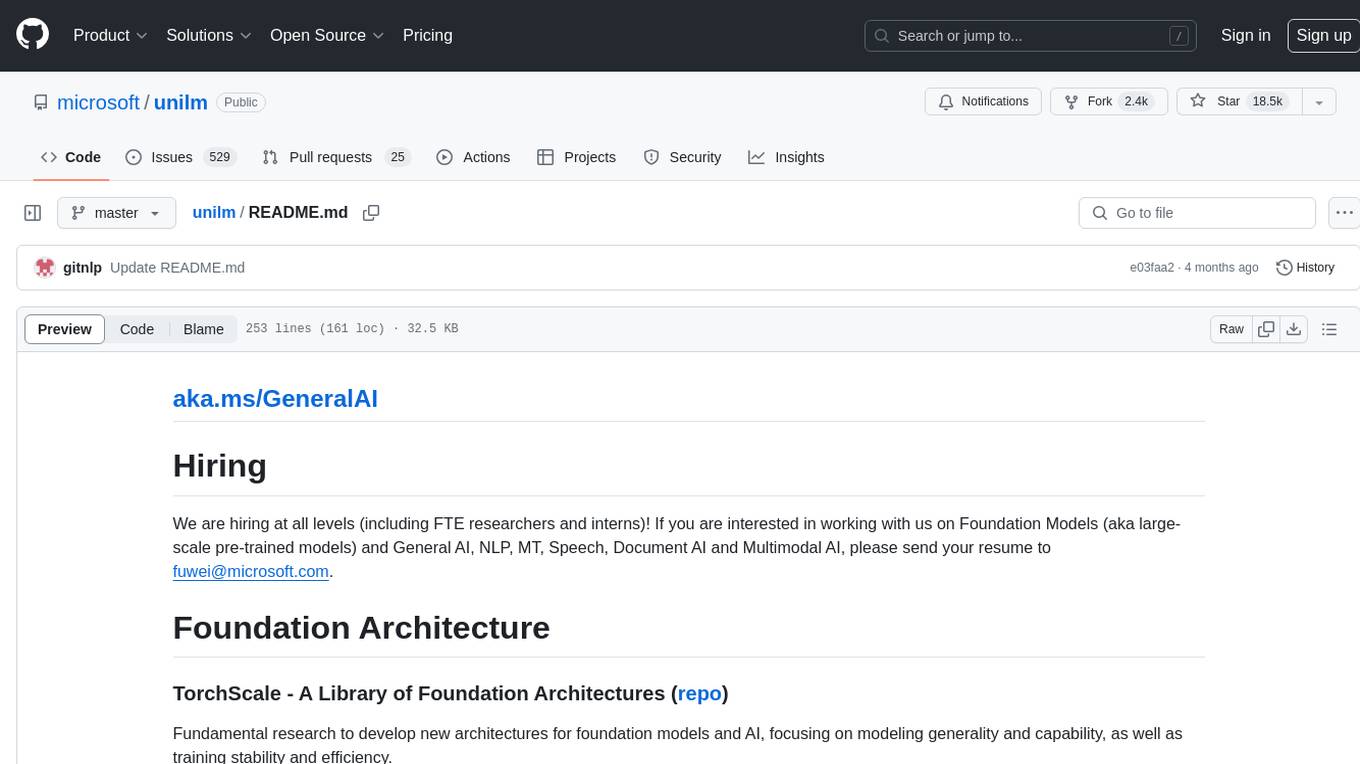
unilm
The 'unilm' repository is a collection of tools, models, and architectures for Foundation Models and General AI, focusing on tasks such as NLP, MT, Speech, Document AI, and Multimodal AI. It includes various pre-trained models, such as UniLM, InfoXLM, DeltaLM, MiniLM, AdaLM, BEiT, LayoutLM, WavLM, VALL-E, and more, designed for tasks like language understanding, generation, translation, vision, speech, and multimodal processing. The repository also features toolkits like s2s-ft for sequence-to-sequence fine-tuning and Aggressive Decoding for efficient sequence-to-sequence decoding. Additionally, it offers applications like TrOCR for OCR, LayoutReader for reading order detection, and XLM-T for multilingual NMT.
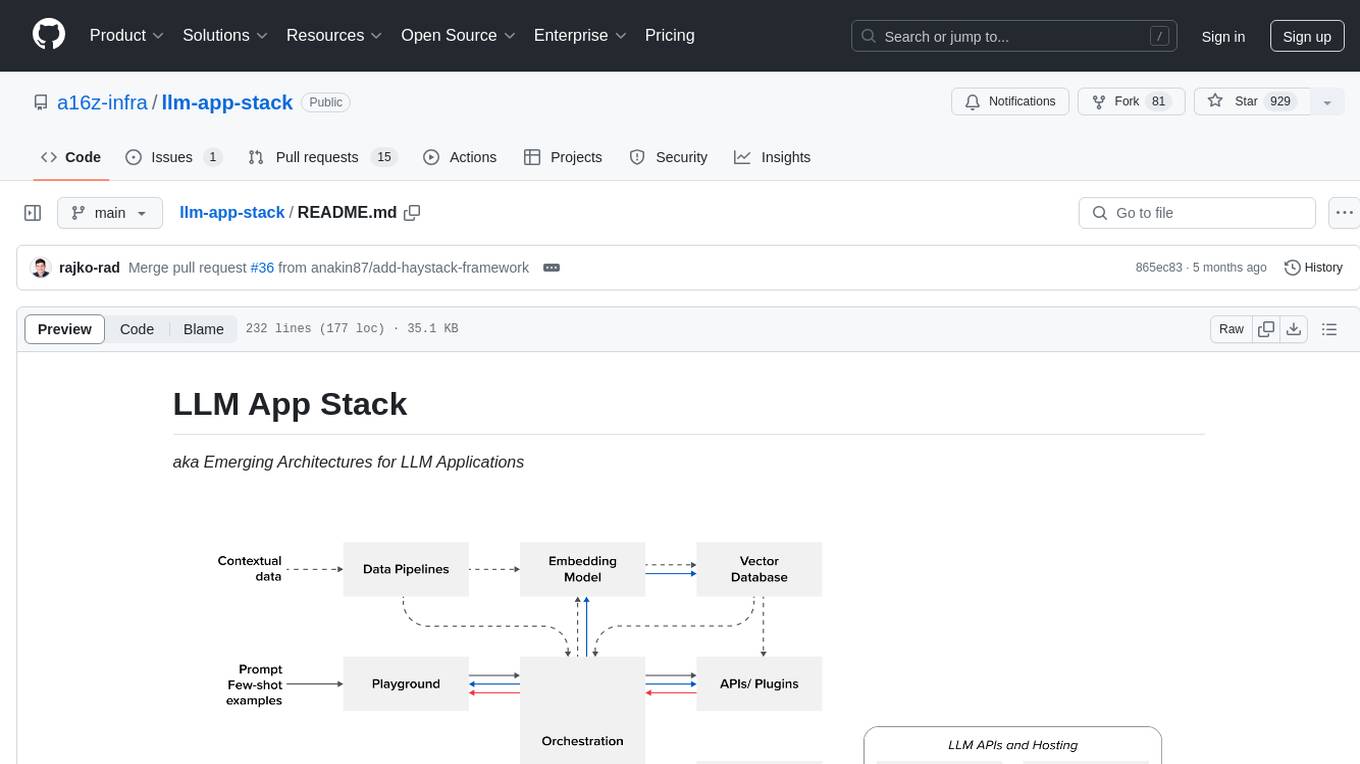
llm-app-stack
LLM App Stack, also known as Emerging Architectures for LLM Applications, is a comprehensive list of available tools, projects, and vendors at each layer of the LLM app stack. It covers various categories such as Data Pipelines, Embedding Models, Vector Databases, Playgrounds, Orchestrators, APIs/Plugins, LLM Caches, Logging/Monitoring/Eval, Validators, LLM APIs (proprietary and open source), App Hosting Platforms, Cloud Providers, and Opinionated Clouds. The repository aims to provide a detailed overview of tools and projects for building, deploying, and maintaining enterprise data solutions, AI models, and applications.
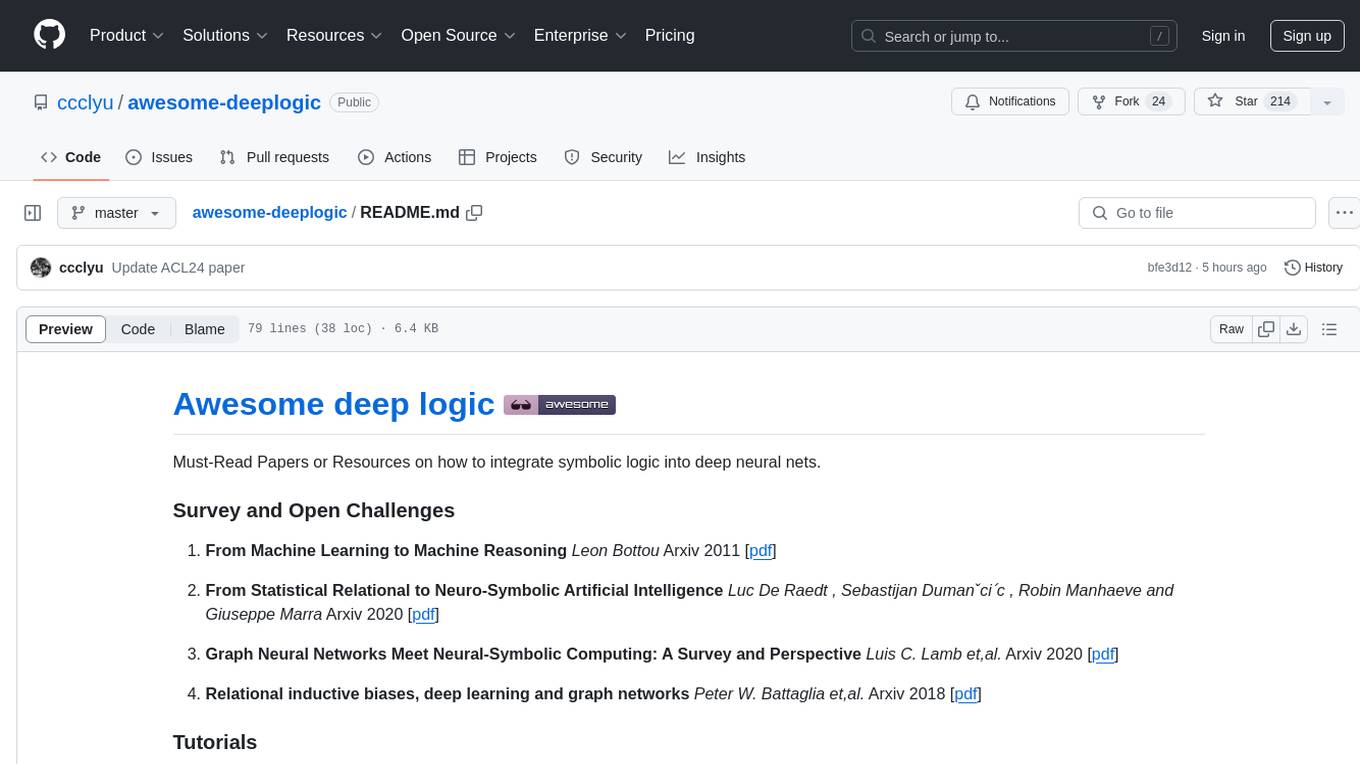
awesome-deeplogic
Awesome deep logic is a curated list of papers and resources focusing on integrating symbolic logic into deep neural networks. It includes surveys, tutorials, and research papers that explore the intersection of logic and deep learning. The repository aims to provide valuable insights and knowledge on how logic can be used to enhance reasoning, knowledge regularization, weak supervision, and explainability in neural networks.

Awesome-LLMs-on-device
Welcome to the ultimate hub for on-device Large Language Models (LLMs)! This repository is your go-to resource for all things related to LLMs designed for on-device deployment. Whether you're a seasoned researcher, an innovative developer, or an enthusiastic learner, this comprehensive collection of cutting-edge knowledge is your gateway to understanding, leveraging, and contributing to the exciting world of on-device LLMs.
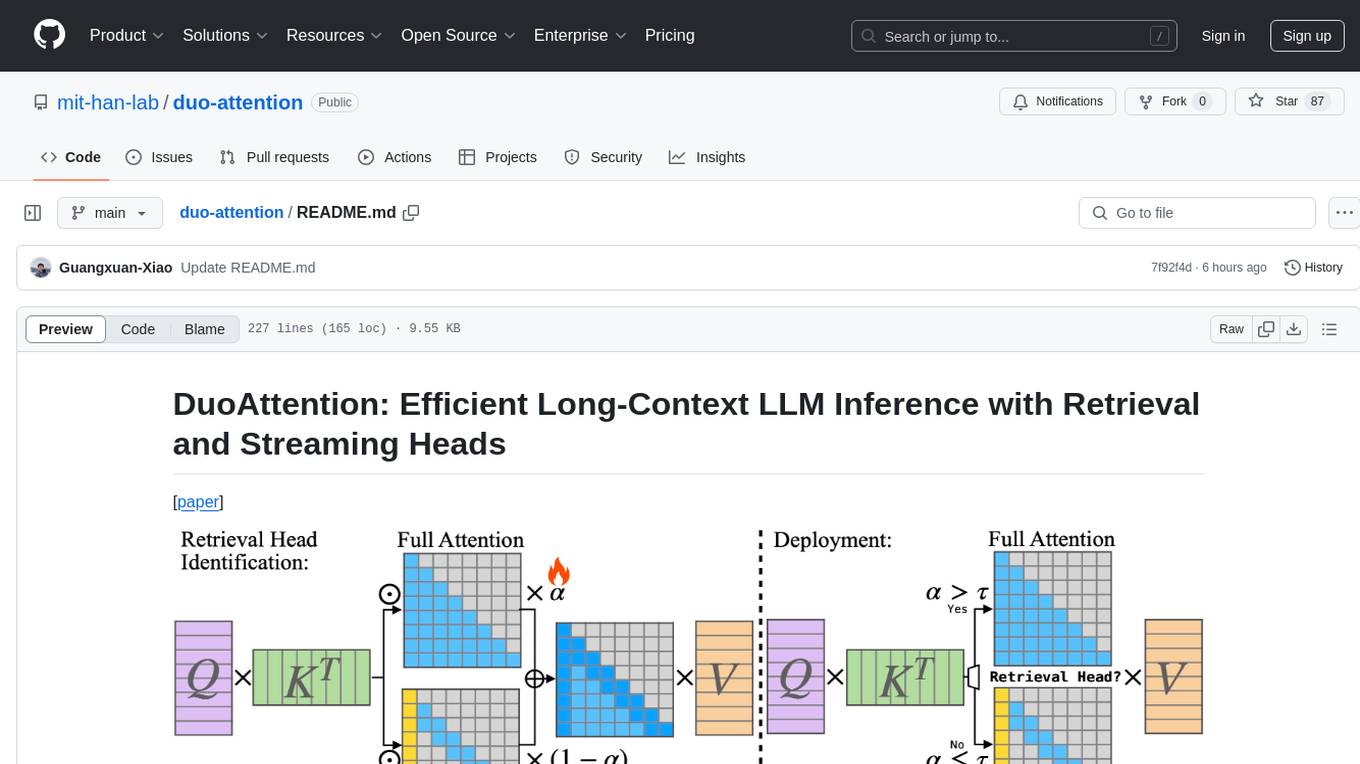
duo-attention
DuoAttention is a framework designed to optimize long-context large language models (LLMs) by reducing memory and latency during inference without compromising their long-context abilities. It introduces a concept of Retrieval Heads and Streaming Heads to efficiently manage attention across tokens. By applying a full Key and Value (KV) cache to retrieval heads and a lightweight, constant-length KV cache to streaming heads, DuoAttention achieves significant reductions in memory usage and decoding time for LLMs. The framework uses an optimization-based algorithm with synthetic data to accurately identify retrieval heads, enabling efficient inference with minimal accuracy loss compared to full attention. DuoAttention also supports quantization techniques for further memory optimization, allowing for decoding of up to 3.3 million tokens on a single GPU.
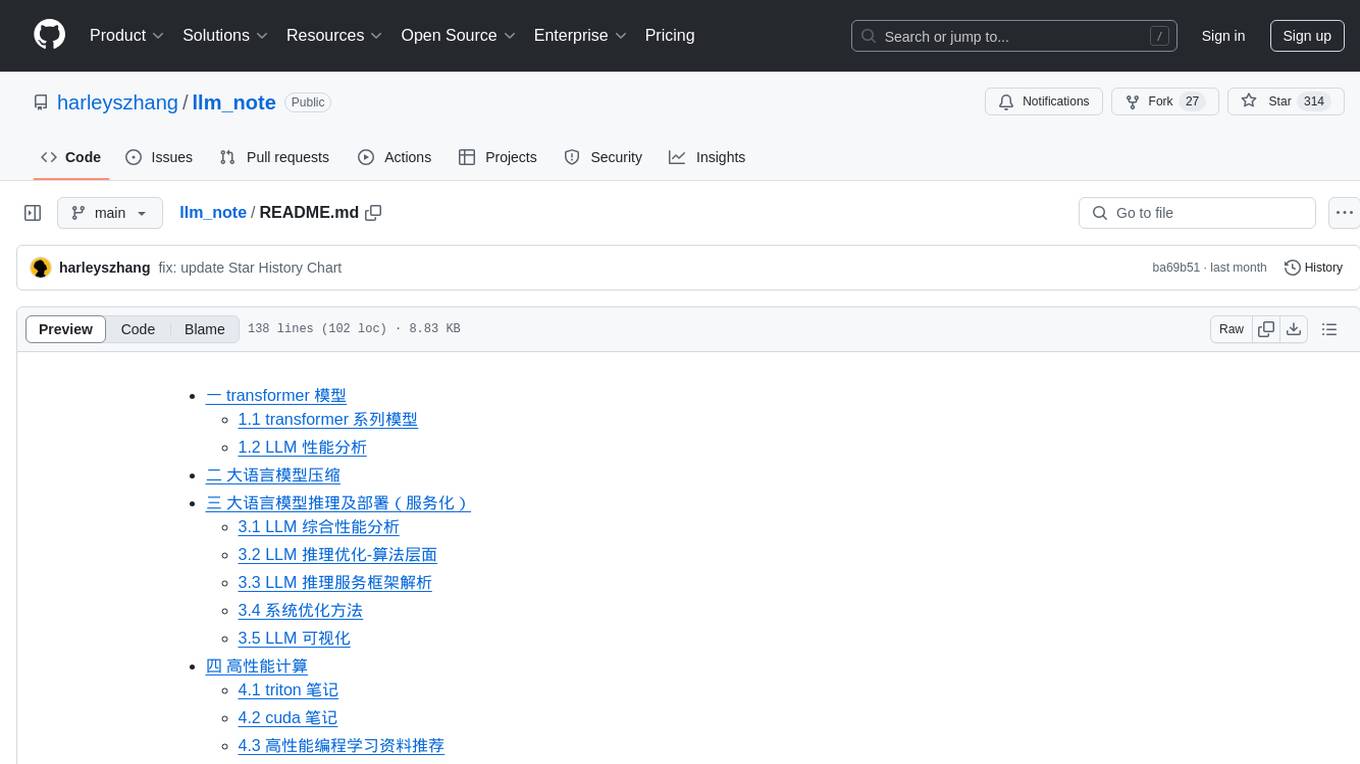
llm_note
LLM notes repository contains detailed analysis on transformer models, language model compression, inference and deployment, high-performance computing, and system optimization methods. It includes discussions on various algorithms, frameworks, and performance analysis related to large language models and high-performance computing. The repository serves as a comprehensive resource for understanding and optimizing language models and computing systems.
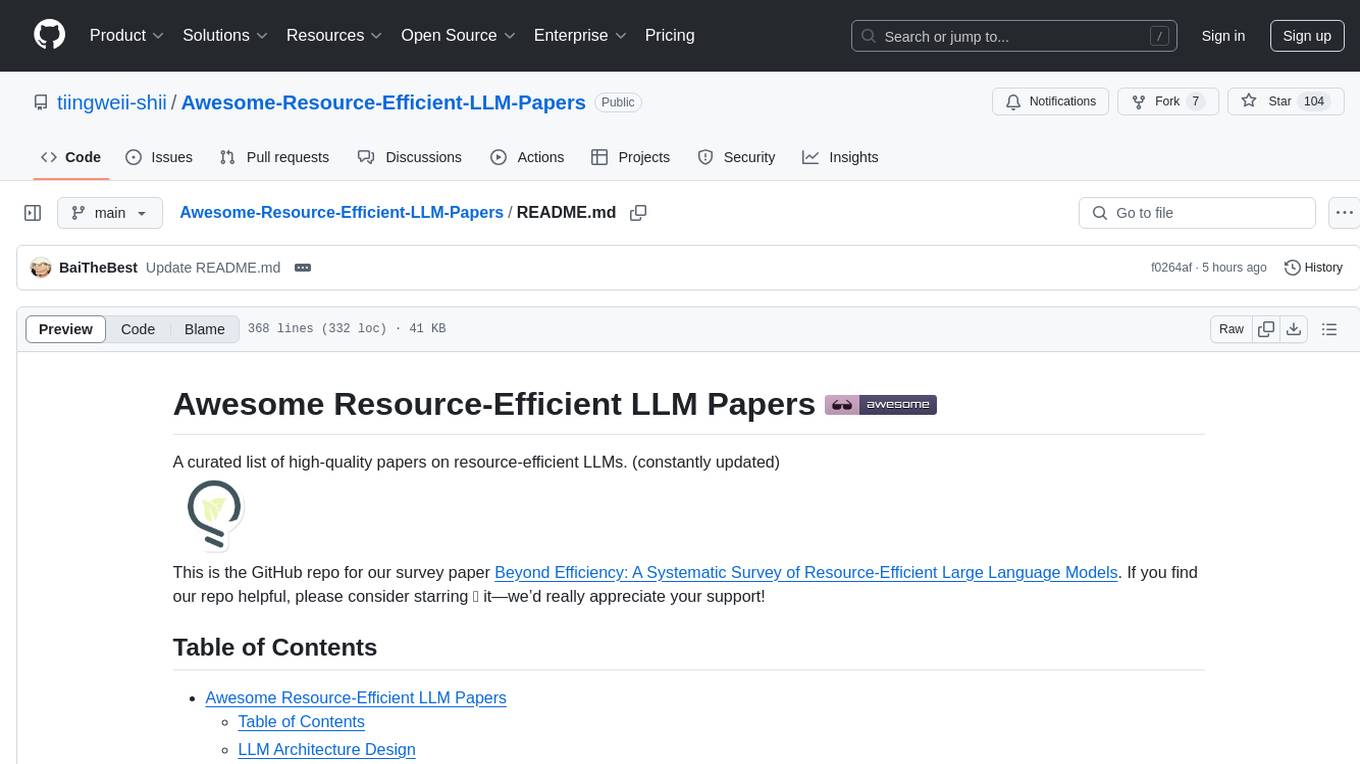
Awesome-Resource-Efficient-LLM-Papers
A curated list of high-quality papers on resource-efficient Large Language Models (LLMs) with a focus on various aspects such as architecture design, pre-training, fine-tuning, inference, system design, and evaluation metrics. The repository covers topics like efficient transformer architectures, non-transformer architectures, memory efficiency, data efficiency, model compression, dynamic acceleration, deployment optimization, support infrastructure, and other related systems. It also provides detailed information on computation metrics, memory metrics, energy metrics, financial cost metrics, network communication metrics, and other metrics relevant to resource-efficient LLMs. The repository includes benchmarks for evaluating the efficiency of NLP models and references for further reading.
